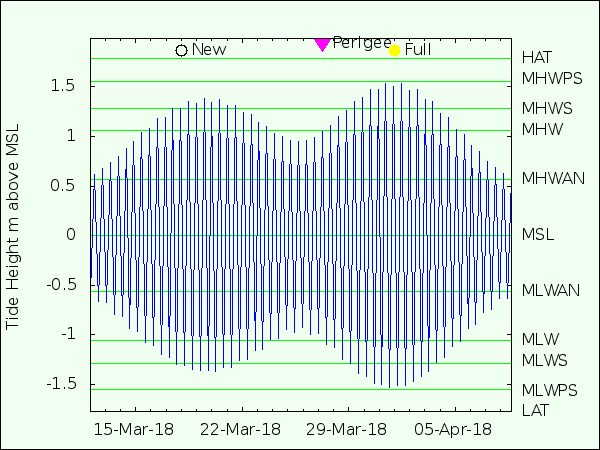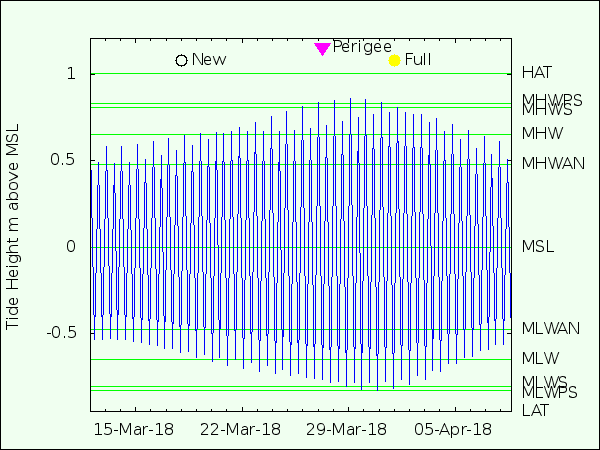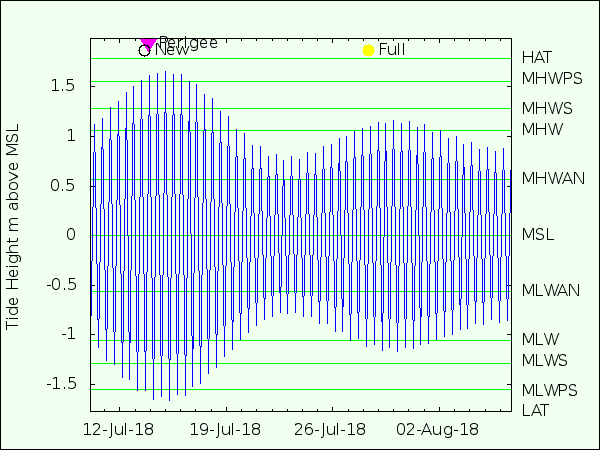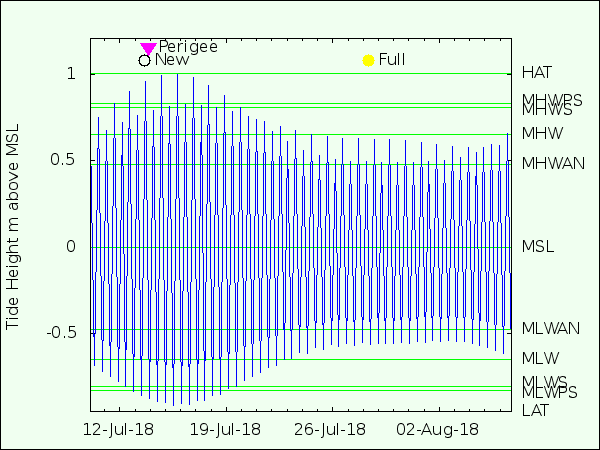 Tides: Effects of Moon's Phases and Apsides
Tides: Effects of Moon's Phases and Apsides
Lunar phases
are explained
here
, and
lunar apsides
are explained
here.
In general, tides are larger at Full Moon, New Moon and lunar perigee (when Moon is closest to Earth).
But around New Zealand, things are not that simple.
Because of the way the tides propagate around New Zealand:
- On the west coast, the effects of the lunar phase dominates, causing a fortnightly spring/neap effect;
- On the east coast, the effects of the lunar apsis dominates, causing a monthly perigean/apogean effect.
These effects can be illustrated by comparing tides at Charleston and Kaikoura on the west and east coasts of the South Island respectively.
The time between New Moons (the synodic month) is 29.53 days, whereas the time between perigees (the anomalistic month) is 27.55 days;
therefore, the time between New Moon and perigee changes from month to month.
Here are two examples with different times between perigee and New Moon:
Example 1: Lunar perigee between New and Full Moon.
Example 2: Lunar perigee coincident with New Moon.
Lunar perigee coincides with a Full or New Moon every 7 months causing large tides, called perigean spring tides,
but also known as "king tides".
Some Technical Details
The reason the tides at these two sites are so different is illustrated in the table below,
which shows the amplitudes of the three main tidal constituents:
- M2: semidiurnal lunar tide - the result of direct gravitational attraction by the Moon;
- S2: semidiurnal solar tide - the reuslt of direct gravitational attraction of the Sun;
- N2: semidiurnal elliptic tide - the result of the elliptic orbit of the Moon
Tidal amplitudes in m.
| |
M2 |
S2 |
N2 |
| Charleston |
1.060 |
0.272 |
0.225 |
| Kaikoura |
0.652 |
0.024 |
0.153 |
The amplitude of the N2 tide is about a quarter of the M2 tide for both sites.
The amplitude of the S2 tide is a quarter of M2 for Charleston,
but for Kaikoura it is only one fortieth of M2.
Both M2 and N2 are related to the Moon, with N2 being a satellite of M2,
which explains why N2 varies in proportion to M2.
Whereas S2 is related to the Sun and is independent of the Moon.
Thus, this effect is related to the way the S2 tide propagates around New Zealand, which can be seen in an animation
here.
Summary
Tides on the west coast of New Zealand have a strong spring/neap effect, with a fortnightly variation in the tides.
But tides on the east coast of New Zealand have a predominantly perigean/apogean effect, with a monthly variation in the tides.
This is caused by the way the semidiurnal solar S2 tide propagates around New Zealand.
Please address enquiries to:
Derek Goring
Mulgor Consulting
Ltd
Christchurch
New Zealand
 Tides: Effects of Moon's Phases and Apsides
Tides: Effects of Moon's Phases and Apsides



